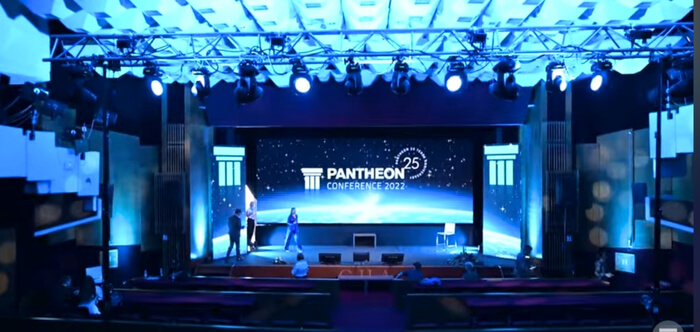Have you ever been invited to a meeting and then another time to a conference and wondered about the nuances that set them apart? Well, you’re not alone. A common question often arises: What is the difference between a conference and a meeting?
The answer is more straightforward than you might think. Conferences have a more formal air to them, distinguished by a preset agenda and a carefully crafted program of activities. On the flip side, meetings can typically be convened at any given time, in whichever space is handy, and often take on an informal tone. Just a few folks gathering around to toss around some thoughts or make a decision.
Join us as we dive deep into the distinguishing factors and nuances of both.
Definition of Conference and Meeting
Conferences and meetings are both essential ways people come together to share ideas, but they serve different purposes and have distinct characteristics. Though often used interchangeably, each has its own unique features and protocols. Let’s explore the core definitions of both.

Conferences, by contrast, are formal events usually scheduled well in advance. These gatherings typically feature an agenda, which often includes keynote speakers, panel discussions, and networking sessions. Participants usually register for the prefered conference to engage with like-minded and international experts, and the event may last for multiple days.
A meeting is often an informal gathering that can happen anytime, anywhere. The primary goal is to discuss a specific subject, problem-solve, or make decisions. Unlike conferences, meetings don’t usually require a formal agenda or planned activities.
What is the Difference Between a Conference and a Meeting?
Both organizers and attendees need to understand the difference between a conference and a meeting. While the two terms are frequently used interchangeably, they describe different types of gatherings with unique attributes. Let’s explore these differences under specific subheadings for clarity.
Level of Formality
A meeting usually embraces an informal approach, conducive to spontaneous conversations and quick decision-making. Conferences, however, are formal events that focus on structured dialogue, punctuated by conference keynote speeches and panel discussions.
Planning and Preparation
In contrast to meetings, conferences involve detailed planning, from coordinating speakers to designing an agenda. Meetings are often arranged with little prep work, making them quicker to initiate and easier to manage.
Duration and Scope
Meetings often last for a shorter period, sometimes as brief as 30 minutes, concentrating on specific objectives. Conferences can span several days and delve deeply into an overarching theme or industry trend.
Agenda and Activities
While a meeting may have an informal agenda, a conference often comes with a planned program. This can include breakout sessions, workshops, and other activities, often detailed in a printed or digital itinerary.
Purpose and Objectives
Meetings are generally tactical and aimed at addressing immediate issues or opportunities within a team or organization. Conferences target broader goals, like knowledge sharing, networking, or industry advancements, involving a larger and more diverse audience.
Participation

When you’re invited to a “meeting” or a “conference,” understanding these differences can help set your expectations and prepare you accordingly. While both facilitate interaction and idea-sharing, they do so in distinctly different settings and styles.
Different Types of Conferences
Conferences are versatile events that serve a variety of purposes and industries. They can be classified into multiple types, each with its own objectives and characteristics. Let’s delve into some of the common types of conferences to understand their specific goals better.
Academic Conferences
Academic conferences serve as platforms for researchers, scholars, and academics to present findings and discuss theories. These gatherings often include paper presentations, panel discussions, and keynotes by distinguished experts. Attendees generally comprise students, faculty, and independent researchers.
Business Conferences
In business-focused events, topics such as market changes, industry trends, and organizational development are addressed. These usually attract professionals from specific sectors and may include workshops, product launches, or strategic announcements. Networking opportunities are often a key component.
Technology Conferences
Tech-oriented conferences cover advancements in fields like artificial intelligence, cybersecurity, or software development. They often feature live demos, coding workshops, and expert panels discussing emerging trends. These events attract developers, engineers, and tech enthusiasts.
Medical Conferences
Medical conferences focus on healthcare topics ranging from clinical research to new treatment modalities. Doctors, healthcare professionals, and medical researchers gather to share findings and advancements. These conferences are crucial for staying updated on medical innovations.
Trade Shows
Though not strictly a conference, trade shows are similar to large-scale events. They provide platforms for companies to showcase their products or services to potential clients and partners. Industry professionals visit these events to explore business opportunities.
Cultural Conferences
These events explore topics like history, art, or social issues and aim to engage the broader community. Speakers may include historians, artists, and social activists. The goal is to foster discussion and promote cultural understanding.
Different types of conferences cater to specific industries, interests, and professional needs. Recognizing the kind of conference you are attending will help you tailor your preparation and expectations, ensuring a more enriching experience.
Difference Types of Meeting
Meetings are ubiquitous in professional settings but come in various forms to serve distinct purposes. Whether you’re brainstorming, decision-making, or team-building, there’s a meeting type that fits. Let’s examine the various types of meetings to differentiate their unique functions.
Status Update Meetings
These gatherings keep team members informed about ongoing projects or organizational updates. Often scheduled regularly, such as weekly or bi-weekly, their goal is to ensure everyone is aligned and aware. Participants usually include team members and project managers.
Brainstorming Meetings
In brainstorming sessions, the focus is on generating numerous ideas related to a project or problem. The atmosphere is typically relaxed to encourage free thought and open discussion. Participants can include a mix of team members, stakeholders, and even external consultants.
Decision-making Meetings
The primary purpose here is to arrive at a decision concerning a specific issue or opportunity. Stakeholders present their views, debate options, and aim for consensus. These meetings often involve higher-level executives and department heads.
Problem-solving Meetings
These meetings tackle specific challenges or roadblocks that a team or project is facing. Collaborative discussion aims to produce viable solutions or alternative approaches. Those who attend are directly involved with the issue at hand.
Team-building Meetings
The focus of team-building meetings is on strengthening relationships among team members. Activities may include icebreakers, group exercises, or motivational talks. These meetings aim to improve collaboration and team morale.
Client Meetings
Client meetings involve conversations between company representatives and existing or potential clients. The primary objectives include understanding client needs, presenting solutions, or finalizing deals. These are crucial for maintaining business relationships.
Knowing the different types of meetings enables better preparation and sets the stage for effective outcomes. Whether you’re sharing updates, solving problems, or forging stronger bonds, identifying the meeting type helps optimize its productivity and purpose.
Pros and Cons of Attending Conferences
Conferences are impactful events that offer a wealth of opportunities for personal and professional growth. However, they also come with certain drawbacks that can’t be ignored. We’ll examine both the pros and cons of attending these formal gatherings below.
Pros
- Networking Opportunities: Meet industry professionals, potential clients, or future collaborators.
- Knowledge Gain: Attend keynote speeches, workshops, and panels to broaden your understanding of industry trends.
- Skill Enhancement: Participate in hands-on workshops or training sessions to improve professional abilities.
- Industry Insights: Learn about the latest advancements, technologies, or market shifts directly from experts.
- Credibility Boost: Speaking or presenting at a conference enhances your professional reputation and expertise.
- Business Promotion: Showcase products or services to a targeted audience, possibly leading to sales or partnerships.
- Motivation Surge: Being around like-minded professionals can boost morale and provide fresh inspiration.
Cons
- High Costs: Registration, travel, and accommodation expenses can be prohibitive for some attendees.
- Time Commitment: Multi-day events require significant time away from work or personal commitments.
- Information Overload: The sheer volume of content can be overwhelming, making retention a challenge.
- Uneven Quality: Not all sessions may offer value; some may be poorly organized or irrelevant to your needs.
- Limited Immediate ROI: Tangible returns on investment, such as new clients or sales, may not be immediate.
Weighing the pros and cons of attending a conference can help you make an informed decision. While the potential for growth and networking is considerable, the financial and time investments should be noticed.
Pros and Cons of Attending Meetings
Meetings are a common feature in the professional landscape, serving as forums for decision-making, problem-solving, and collaboration. While they can offer many advantages, drawbacks are also part and parcel of the experience. Below are the pros and cons of attending meetings.
Pros
- Quick Decisions: Allows for real-time dialogue that can speed up the decision-making process.
- Team Alignment: Ensures all team members are on the same page regarding projects or tasks.
- Relationship Building: Fosters better interpersonal connections among colleagues or stakeholders.
- Problem-solving: Offers a collaborative environment for identifying issues and crafting solutions.
- Direct Communication: Provides a forum for immediate feedback and clarification.
- Accountability: Keeps team members responsible for their roles and tasks.
- Flexibility: Can be quickly arranged to address urgent or unplanned matters.
Cons
- Time Drain: Poorly planned or unnecessary meetings can consume valuable time.
- Limited Engagement: Not all attendees may participate actively, leading to skewed outcomes.
- Agenda Drift: Discussions can veer off-topic, reducing meeting effectiveness.
- Over-dependence: The ease of scheduling meetings might discourage independent problem-solving.
- Remote Challenges: Virtual meetings may face tech issues or lack the engagement of in-person interactions.
Attending meetings has both advantages and disadvantages, affecting productivity and team dynamics. Assessing these pros and cons can guide you in optimizing your approach to meetings, making them more effective and purpose-driven.
Final Considerations
In guiding the professional landscape, understanding what is the difference between a conference and a meeting can set the stage for more productive and meaningful engagements. While conferences offer a formal environment for deep learning, extensive networking, and industry exposure, they do require significant time and financial investment.
Meetings, on the other hand, are typically less formal, more flexible, and better suited for immediate decision-making and team alignment. However, they come with their own set of drawbacks, such as time inefficiency and limited engagement.
Knowing the purpose, pros, and cons of each type of gathering can help you make informed choices, optimize your participation, and ultimately drive your professional or organizational growth.







